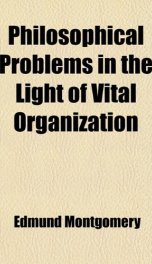philosophical problems in the light of vital organization

Purchase of this book includes free trial access to www.million-books.com where you can read more than a million books for free. This is an OCR edition with typos. Excerpt from book: have sometimes consciously, sometimes unconsciously, done essential service in philosophical interpretation. In modern times mathematical and mechanical principles and methods have intentionally and conspicuously guided the thought of most leading philosophers. Galileo laid the foundation of scientific mechanics by demonstrating the accelerating effect of forces upon bodies, which involved the " law of inertia," expressive of the intrinsic import of " mass" in the motion of bodies. Gassendi revived Epicurean atomics, and before long the reduction of all physical, indeed of all natural occurrences, to atomic mechanics became the generally acknowledged aim of exact science. And among biologists, as well as physicists, the reduction of natural occurrences to measurable quantities, expressible in mathematical equations, remains still the end aimed at. Descartes believed in an out and out mechanical construction and operation of extended nature, organic structures and functions included. Hobbes attributed supreme reality to extension and motion mechanically actuated, and held methods of mathematical computation to be strictly applicable to philosophical problems. Spinoza sought to evolve the content of his absolute substance in accordance with Euclidean methods. The principal philosophical aim of Leibnitz was to harmonize the mechanical interpretation of extended nature with the manifestations of unex- tended thought. Meanwhile, the experimental investigation of natural phenomena, fostered by the "Royal Society" determined Locke's and his followers' method of questioning "Human Understanding." And Newton's influence guided Kant not only in his physical butalso in his philosophical researches. He never relinquished his belief in the rigorous mechanism of nature, and mathematics ga...
Info about the book
Author:
Series:
Unknown
ISBN:
1113866640
Rating:
4.5/5 (4)Your rating:
0/5
Languge:
English
Users who have this book
Users who want this book
What readers are saying
What do you think? Write your own comment on this book!
write a commentif you like philosophical problems in the light of vital organization try:
Other books by this author
Do you want to read a book that interests you? It’s EASY!
Create an account and send a request for reading to other users on the Webpage of the book!

